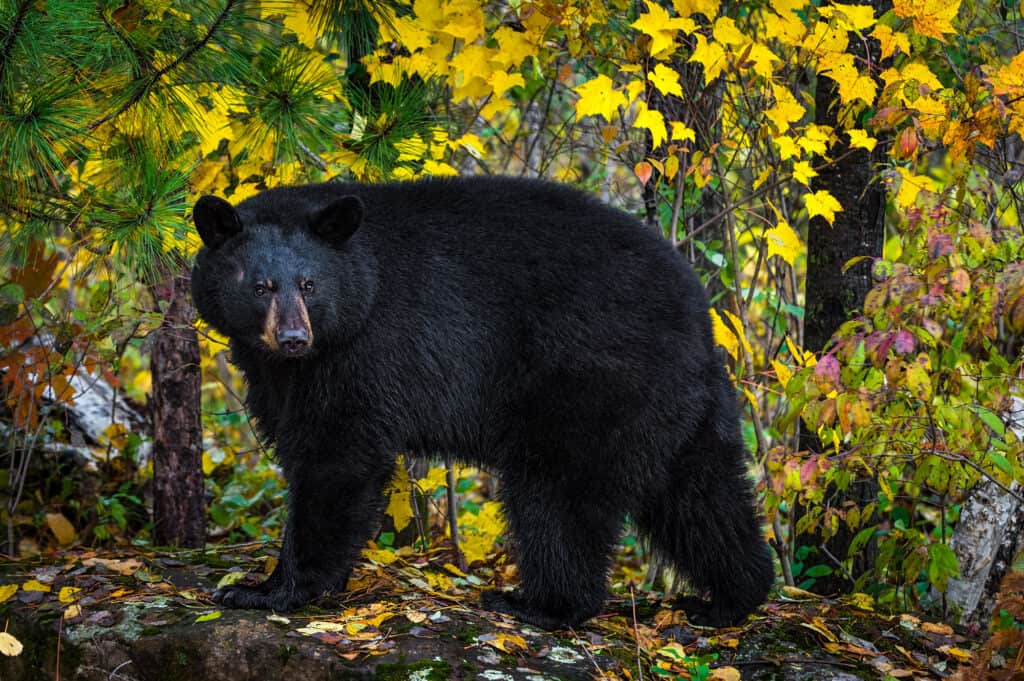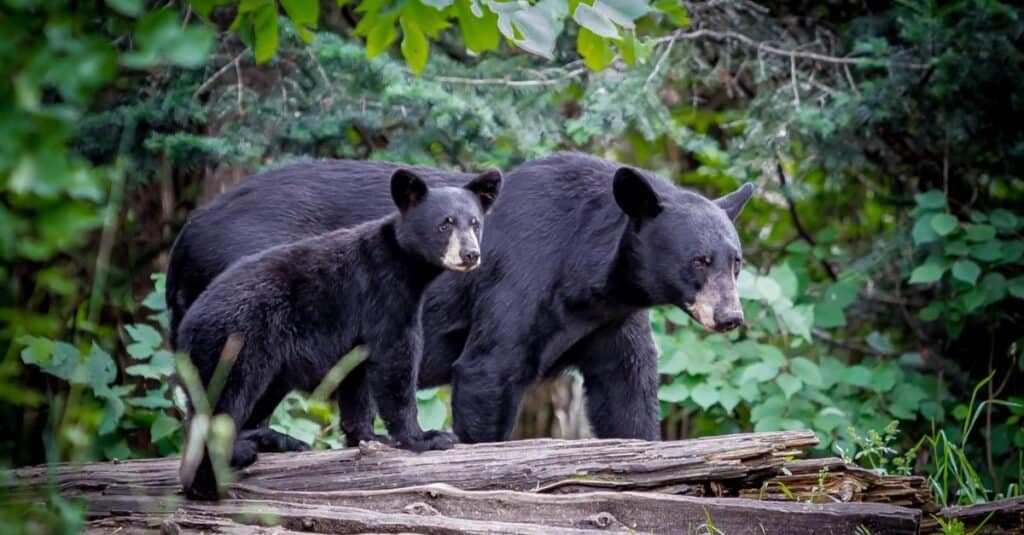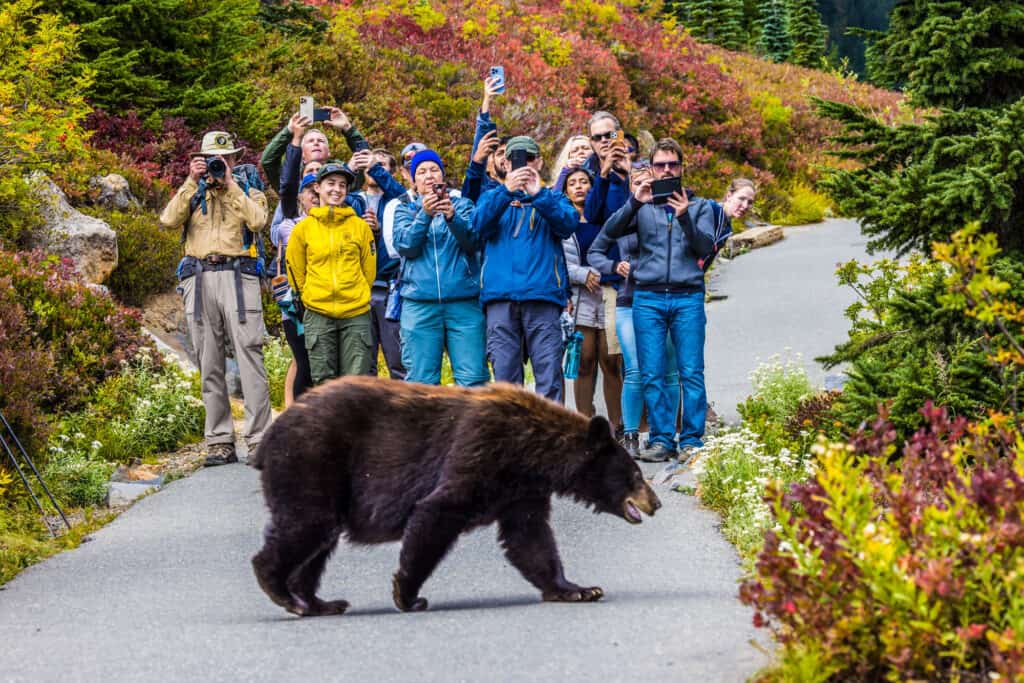Did you know there are around 25,000 black bears in the state of Washington? If you go on a hike in the right area, you might just get to behold these beautiful animals in their natural habitat. You also might see one crossing the street in your neighborhood. So where do all these black bears live? This article will explore Washington State and all the places you can find black bears.
What Are Black Bears?

Black bears are generally shy and will usually avoid contact with humans. However, they can become habituated to human food sources and become a nuisance in residential areas if they are not properly managed.
©Holly Kuchera/Shutterstock.com
The American black bear and the Asiatic black bear are the two species of black bears alive today. Although they are closely related, they are different species. The American black bear is Ursus americanus and the Asiatic black bear is Ursus thibetanus. They belong to the same genus but the species diverged about 300,000 years ago.
Despite their name, black bears can come in a variety of colors including various shades of brown. They typically have a lighter color snout. Black bears lack the characteristic hump that brown bears have between their shoulders. They also have much shorter claws and taller ears than brown bears.
Black bears in the western United States tend to weigh between 100 and 300 pounds and stand 2.5-3 feet at the shoulder. Black bears are typically hypocarnivores. This means that meat comprises less than 30% of its diet and they rely primarily on plant material including various types of berries.
Where do Black Bears Live Around the World?

The Washington Department of Fish and Wildlife estimates that the black bear population in the state is around 25,000 individuals and is relatively stable, although there have been declines in some areas due to habitat loss and other factors.
©jo Crebbin/Shutterstock.com
Black bears have a very broad distribution. The American black bear inhabits most of North America’s forests including in the US and some Canadian provinces. The Asiatic black bear inhabits southeastern Asia including Bangladesh, China, and Korea. They also exist throughout Siberia.
In the United States, there are between 339,000 and 465,000 black bears! This estimate does not include Alaska, Idaho, South Dakota, Texas, and Wyoming. About 100,000 black bears are in Alaska, which has the largest population in the US!
Alaska is also home to brown bears and polar bears. A brown bear subspecies that lives exclusively in Alaska is the Kodiak bear. California has the largest black bear population in the contiguous United States. The statewide population estimate is between 30,000 and 40,000 bears!
One of the areas with the densest black bear populations in the US is in Great Smoky Mountains National Park. There are about 1,500 bears across all elevations. In fact, on average there are two bears for every square mile!
The total Canadian black bear population is about 396,000 to 476,000. This estimate does not include black bear population evaluations in New Brunswick, the Northwest Territories, Nova Scotia, and Saskatchewan, though. The total population count is likely significantly larger. Black bears have been locally extinct on Prince Edward Island since 1937.
What is the Lifespan of a Black Bear?
Black bears are large, omnivorous mammals that are found throughout much of North America, including in Washington state. These fascinating animals are known for their shaggy fur, powerful jaws, and impressive climbing abilities. But how long do black bears live?
In the wild, black bears have an average lifespan of around 20 years. However, some individuals have been known to live longer, with some females reaching 25 years or more. The lifespan of a black bear is influenced by a variety of factors, including genetics, diet, and environmental conditions.
In captive environments, black bears can live even longer. Captive black bears that receive proper care, such as a balanced diet and suitable living conditions, have been known to live into their 30s or even 40s.
It is important to note that black bears are vulnerable to a variety of threats, including habitat loss, hunting, and human-bear conflicts. The lifespan of a black bear can be significantly reduced in areas where these threats are prevalent, making it all the more important to support conservation efforts to protect these fascinating animals.
Where do Black Bears Live in Washington State?

In Washington, black bears are classified as a game species and are regulated through hunting and trapping seasons.
©Leo Kohout/Shutterstock.com
Black bears live throughout Washington State including in protected natural areas and suburban areas. They are widespread across the state except in the arid Columbia Basin. Grizzly bears also live in Washington, but they are rare and exist only in small populations. Reports of grizzlies have been made in the Selkirk Mountains in northeast Washington, and potentially in the Okanogan Highlands and North Cascades.
Natural Areas
Black bears are common in parks and other protected natural areas across the state. They occupy a number of different habitats including coastal rainforests, montane forests, alpine slopes, and dry woodlands. The Cascade mountains are a major topographical feature in Washington and are home to many black bears.
The frigid northern Cascades, the dry eastern Cascades, and everywhere in between have some level of black bear presence. The bears attract many curious hikers and animal lovers who can watch the gigantic animals in their natural habitats. Just be sure to give the bears plenty of space!
If you are interested in finding a hike with frequent black bear sightings, there are hundreds of trails and trip reports on the Washington Trails Association’s website. One beautiful trail in the Northern Cascades National Park with a resident black bear is called Cascade Pass and Sahale Arm. This is a difficult hike but is well worth the suffering for the incredible mountain views.
Approximately 4-5 miles into the hike is Lake Doubtful (not a very reassuring name, but it is beautiful). Past that near Sahale Glacier, a male black bear is often reported by hikers and campers.
Although he must still be respected as a wild animal, he has become used to seeing hikers, has no history of aggression, and tends to avoid people. If you choose to hike where bears are present, always follow safety protocol and let someone know where you are going.
Inhabited Areas
Black bears are often sighted in residential neighborhoods including places on the east side like Issaquah, Samammish, Redmond, Woodinville, Snoqualmie, and many more. Most human-bear encounters are a result of irresponsible food handling by humans.
Access to trash, bird feeders, pet food, or other improperly stored food can attract black bears. Bears are opportunistic feeders and will exploit a variety of food sources in inhabited areas when the food of their typical diet is scarce.
In the fall and early winter, bears prepare for hibernation and may be more assertive in their search for food. During this season, it’s important in areas where bears frequent to monitor trash and other smelly things that might attract bears.
If you lock your trash bin or close it in a bear-proof container, shed, or garage, you will greatly reduce the likelihood of a bear successfully invading your trash. Once a bear is successful in obtaining food in a residential area, the likelihood of it returning to that neighborhood increases.
Bear Encounters: Black Bear vs Brown Bear

Female black bears typically give birth to two cubs every two years and are fiercely protective of their young.
©nyker/Shutterstock.com
If you come face to face with a bear, there are a couple of different ways to react. First, it is important to note that with both brown bears and black bears, mothers and their cubs are potentially the most dangerous to run into. Mothers are very protective and are likely to perceive someone as a threat to their offspring.
It is also important to know what type of bear you encounter. You can identify a brown bear or grizzly bear because they are most often brown, they have a hump between their shoulders, they are larger, and they have longer claws. Black bears are typically black, have no hump between their shoulders, and are usually smaller than brown bears. Grizzly bears tend to be more aggressive than black bears and attack more often.
Responding to an Encounter
If you see a black bear, make lots of noise such as saying loudly “Hey bear! Hey bear!”. Make yourself look big and do not back away. Hold your ground and continue making noise until the bear leaves. Do not try to escape by climbing a tree because black bears are very good climbers.
In a brown bear or grizzly bear encounter, seek shelter in a building or vehicle if possible. If you can’t get away, back away from the bear and make yourself look small. Avoid making eye contact and slowly move away until the bear loses interest and leaves. If the bear charges, do not fight back. Lay on your stomach with your legs partially spread so the bear can’t roll you onto your back.
If you have a backpack on, keep it on your back, protecting your neck if possible. Put your hands behind your head or neck for protection and use your elbows to also prevent rolling over. Maintain this position and eventually, grizzlies most often lose interest and leave.
Fun Articles Up Next:
- Black Bear Populations by State
- Are Black Bears Aggressive?
- Black Bear vs. Brown Bear: who would win in a fight?
- Watch a Black Bear Casually and Expertly Steal a Free Meal
- Watch Two Black Bears Brawl in New Jersey
The photo featured at the top of this post is © Holly Kuchera/Shutterstock.com
Thank you for reading! Have some feedback for us? Contact the AZ Animals editorial team.







